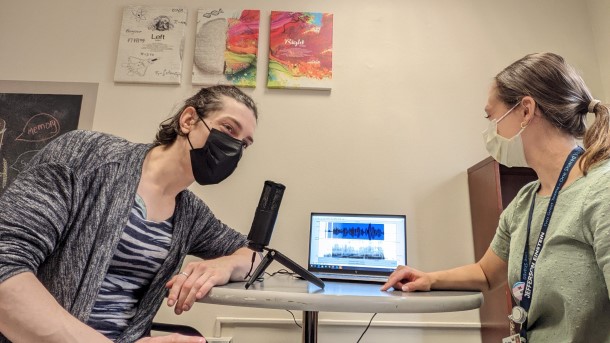
Ever hear a voice and know exactly who it is without seeing them? Our voice distinguishes us as much as our facial structure, fingerprints, or gait. It is a unique part of our identity. MossRehab, in collaboration with the Einstein Pride Program, offers a special type of vocal training to help individuals seeking gender-affirming care (support in the gender transition) find the voice that represents them.
Transgender (people whose gender identity is different from the gender assigned to them at birth) and gender expansive (those who expand notions of gender expression and identity beyond perceived or expected societal gender norms) people often seek a voice that makes them feel comfortable and authentic to themselves.
“Voice therapy helps individuals safely find a vocal sound that defines their identity,” notes Alyssa Giegerich, MA, CCC-SLP, a MossRehab speech-language pathologist who specializes in gender-affirming voice therapy. “It’s not easy to learn how to adjust the voice by watching YouTube videos or working alone. Voice care from an experienced speech-language pathologist prevents vocal abuse and overuse by doing too much or going too high with a pitch.”
What is Voice Therapy?
Voice therapy is different from speech therapy because it focuses on adapting voice in a gender affirming way rather than rebuilding motor speech or articulation after a voice injury from a neurologic issue such as a stroke or a degenerative disease such as Parkinson’s. Voice therapy focuses on varied vocal nuances including pitch, resonance (how the voice vibrates), volume, and intonation (rise and fall of voice). It also relates the physical and social aspects of speaking to gender. For example, conversations ending with upward intonation and using filler words such as “like” and “um” are perceived as more feminine.
Because every voice is different, speech-language pathologists work with individuals to determine their specific goals and what sounds natural to them. In some cases, gender stereotypes are not a desired trait.
“Voice therapy is different for everyone. People might want a masculine, feminine, or gender-neutral voice,” says Giegerich. “Sometimes, people's goals change, and they no longer want to reach a higher pitch. It’s a process that’s different for everyone.”
Everyone’s Journey is Different
Everyone's gender-affirmation journey is different. “I had a patient who was a singer and identified as gender expansive,” says Giegerich. “They had testosterone therapy seeking a more gender-neutral speaking voice. However, the hormone regimen impacted their singing voice. People receiving testosterone therapy may find that their voice deepens but cracks.” Giegerich provided voice therapy that worked on pitch range and smooth transitions between high and low pitches.
For one transgender woman (female person assigned male at birth), Giegerich worked on conversational speaking, starting with simple sounds such as “ooh” and “ah”, then moved into single words, phrases, sentences, and conversation. “In addition to working on target pitch, I wanted to ensure she had enough breath support, and didn’t strain or push the voice,” says Giegerich. “We wanted to make the voice natural and used an up and down melodic intonation to achieve it.”
Some people may want a more neutral voice to avoid perceptions of their voice as either feminine or masculine. The goal in this situation is to achieve a voice that is in the middle and less of a certain perceived gender.
Once finding the desired voice, individuals become more comfortable and confident in themselves in different social settings and safer in public places such as work. “Some individuals may be bothered by how they are perceived when talking on the phone. Others are afraid to speak in a public bathroom because they may be misgendered,” notes Giegerich. “Finding the right voice makes the transgender community feel authentic and true to themselves.”
The Voice Transition Process
Attaining the desired natural voice is not a quick process, requiring at least 8-10 weeks of therapy. Individuals may return to therapy many times to push further, correct old habits, or refresh practices.
“During the initial weeks of therapy, people gain a foundation of knowledge of how to work on their voice, but it requires effort for a long time,” says Giegerich. “In the short term, they may challenge themselves to try this newfound voice in one social setting such as ordering in a restaurant. After becoming more comfortable, individuals can practice talking to people in different parts of their lives.”
To get started with voice therapy at MossRehab, individuals should contact the Einstein Pride Program. A Pride patient navigator will help coordinate a variety of healthcare services for patients seeking gender-affirming care.